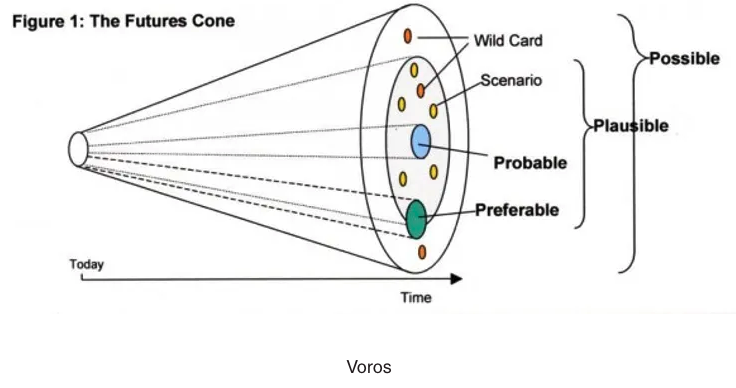 “If you are proactive, you focus on preparing. If you are reactive, you end up focusing on repairing.” – John C. Maxwell
“If you are proactive, you focus on preparing. If you are reactive, you end up focusing on repairing.” – John C. Maxwell
We live in a Volatile, Uncertain, Complex and Ambiguous (VUCA) world. And our climate crisis guarantees it will remain a VUCA world for decades. Climate touches everything so it has knock on effects in society, technology, economics and politics, and, obviously, on our ecosystem.
Traditionally, uncertainty has been the enemy of business leaders. How does one forecast and strategize when living in a time when anything can happen? The first step is to change how we perceive uncertainty. What if we embrace it?
Having a specific issue to focus on simplifies this process. My focal issue is climate impacts – the threats, risks and opportunities resulting from our climate crisis. Your focal point is your organization. It will be impacted by climate in several ways over the coming days, weeks, months, years and decades. The viability of your organization will be affected by how well you assess and manage your climate risks and opportunities.
So what can organizations do after identifying a range of possible futures?
Narrow the futures cone to identify those that are not only possible, but plausible. After that, identify the probable futures… those most likely to come about. To do that, it is important to identify the key drivers of change pertinent to your focal issue and monitor them systematically.
Then, determine which probable future you most want to see become reality. Develop a strong vision of your preferred future and take action to pull your organization to that preferred future. At the same time, understand that events may cause other futures to emerge. To ensure your organization is ready, outline a portfolio of different scenarios to ensure your organization is prepared for contingencies.
Scenario planning can help by making that strong vision of your preferred future more tangible. We are hard wired to remember and act on stories. Scenarios are future stories.
Scenario Planning
Leaders who can expand their imaginations to see a wider range of possible futures are much better positioned to take advantage of the unexpected opportunities that will come along. Scenario planning reduces the unlimited number of potential futures into a limited number of likely futures. Scenario planning charts those likely futures and, crucially, describes a narrative for each. By painting a picture of each future, all stakeholders can then visualize, internalize and interrogate each future. Thus reducing uncertainty and increasing agency. They know where they are going.
Backcasting
Once a preferred future scenario has been identified and described, backcasting is a way of determining the steps needed to reach that future. It answers the question, “what do we need to do today to reach that future outcome?” That is then used to develop the plan and budget to get from here to there.
Horizon Scanning
Horizon scanning is protracted vigilance across a number of relevant trends. It focuses on discontinuities, emerging issues, and weak signals of change. We use it as an early warning system to identify potential disruptions to our strategic plan to reach our preferred future. If and when a potential disruption is discovered, it is analyzed to determine whether it can be safely ignored, or if corrective measures need to be taken, or (in a worst case scenario) if the disruption necessitates a pivot.
Below I’ve outlined three probable futures as they relate to preparing for the impacts (risks and opportunities) of climate change on an organization.
Business as Usual
I mentioned above that a core desire is to survive. Let’s start there.
Tweaking Around the Edges
In this scenario, leadership decides to address the issues, but half-heartedly. The government mandates that they measure their carbon footprint, so they do, but it ends there. They go through the motions, produce the report and then it sits on a shelf. This reflects a bias toward incrementalism borne from a belief that we will return to “normal”. As I wrote above, that is not going to happen… not a chance.
Components manufactured in China are becoming more expensive due to rising shipping costs and delivery disruptions. So leadership rearranges their budget, by looking for other areas to reduce costs, and plans longer lead times for the components.
Leaders instruct HR to institute a hybrid work schedule for those employees who don’t need to work onsite, and to only hire new people with the understanding that they will work 100% on site no matter what the position/role.
These half measures help – they keep the boat afloat. But it’s a risky tactic because it does nothing to meet the challenges of a VUCA world amid the growing turbulence caused by our climate crisis… plus a host of accelerating social, technological, economic and political trends.
Future Fit Transformation
What if you are the type of leader who views survival as not enough? What if you want your business and yourself (and all your stakeholders) to thrive?
What if you identified the specific climate risks your operations are vulnerable to and took action to mitigate them?
What if you inventoried your internal resources, your tools and technologies, your intellectual property and partnerships to uncover latent capabilities that can be repurposed as climate opportunities… innovative products and services that your existing customers (and new ones) will want in five or ten years?
That’s a tall order, but it’s doable. It requires long term planning (something you know you should be doing). And it requires money. Will investors balk? Perhaps. But if you can paint a compelling picture of your preferred future, many will choose to stick with you. The scenario planning process has supplied that preferred story of your organization’s future.
If you have a well-researched climate transition plan… including a timeline with milestones and a budget outlining how you will get from here to there; plus a compelling future scenario narrative; plus an acknowledgement that stuff happens and a plan to handle that (horizon scanning); you’ll find the money that you need.
It’s so much better to have a plan to avoid disaster than to be forced to deploy a disaster recovery plan.
Fugro – Case Study of a Successful Climate Transition
“For Fugro, sustainable business means that we continuously rethink what we do and how we do it. We unlock insights from Geo-data, a critical element for the sustainable development and operation of our clients’ infrastructure, plants, buildings and natural resources. With our products, services and innovative solutions, we directly contribute to modern infrastructure, climate change mitigating projects such as flood and coastal protection, and safe and efficient power grids.
Fugro plays an important role in the ongoing energy transition with the development of renewable energy assets such as offshore windfarms, while assisting in safe and efficient development, construction, operation and decommissioning of fossil fuels while this is still an important part of the global energy mix. Fugro, together with its clients and other stakeholders, plays a fundamental role in creating a safe and livable world.”
That isn’t PR or greenwashing, or marketing speak… it is a commercially focused strategy designed to make the organization thrive in the “new abnormal”. They took transformation seriously and they are positioning to be a major player in a zero carbon economy. You can see some of their solutions here. They have made our climate crisis the centerpiece of their transformation… and it is paying off.
It is likely that your business does not have the extent of climate impacts Fugro was vulnerable to. Yet no matter what your business, you will be impacted. It’s best to assess those potential impacts so you can manage your risks and leverage your opportunities
Using Climate to Catalyze Culture and Purpose
Effective leaders build a strong organizational culture by binding stakeholders together via a common purpose. What better purpose than addressing the most serious threat humankind has ever faced? Our climate crisis imperils every species, government, business, institution, community, family and individual on Spaceship Earth.
The unfamiliar and uncertain often taps into the fear element of our fight-or-flight warning system. We need to overcome our initial fear and move forward, using the challenge to innovate and adapt. If we allow ourselves to become trapped in the uncertainty, our modus operandi becomes firefighting. Firefighting is not a strategy.
Move from the day-to-day operational considerations of management to the longer-term transformative dimensions of leadership.
Shared purpose does not, in and of itself, offer answers to immediate challenges we face in our work. Fixes in today’s uncertain landscape are fleeting. The ability of an entire organization to consistently adapt over and over again requires the whole crew of stakeholders, not just the C-suite. And to orient the whole crew takes a North Star. A common purpose known and accepted by all provides context and direction for every decision, every action, by every person, every day. That’s how a challenging, even uncertain, landscape becomes an opportunity.
Uncertainty requires a willingness to engage in the discovery process and embrace others’ ideas. It’s a signal that there’s not one right answer and we’re all on the same path together. The difficulty involved in grappling with uncertainty means the lessons learned, knowledge gained, and experience garnered will be long lasting. What comes easy is easily forgotten.
Be Prepared
Your business may not be as well positioned for a complete makeover as Fugro, yet you are vulnerable to climate risks, and you likely have unrecognized climate opportunities. Please consider creating a climate transition plan as I’ve outlined above.
Each organization will experience different climate impacts specific to their locations, supply chains, products and services and many other variables. It is not a matter of “if” but “when”. Taking the time, doing the work, and making the investments to prepare for impacts (both risks and opportunities) will make all the difference as we progress through an ever more VUCA environment.
BIO:
Sign up here to receive our weekly Crew Commentaries.
Bob Leonard is the Chief Content Officer at This Spaceship Earth and the Managing Consultant at Climate Foresight Advisory.
